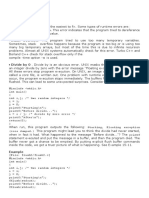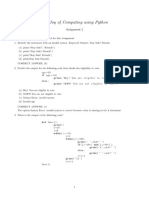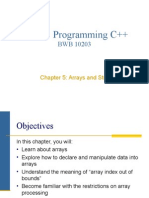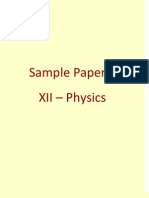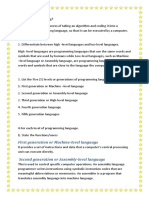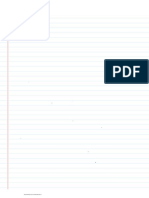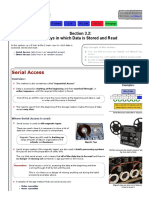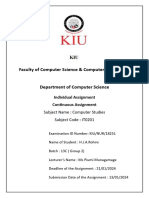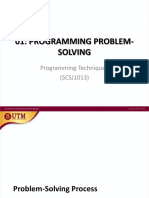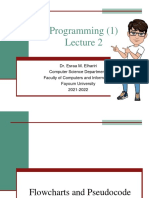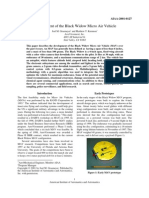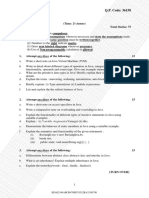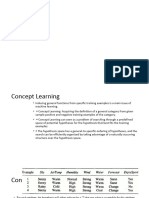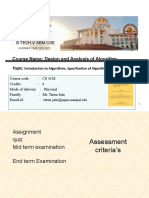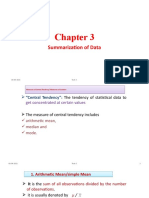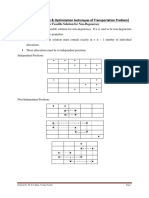Problem Solving
Programming Process
Programming is a process of problem solving
Problem solving techniques
Analyze the problem
Outline the problem requirements
Design steps (algorithm) to solve the problem
�Programming Process
This week
�Input, Processing, Output
�Input, Processing & Output
Three steps that a program typically performs:
1) Gather input data: from keyboard from files on disk drives 2) Process the input data 3) Display the results as output: send it to the screen write to a file
�Example 1
Develop a program to calculate area of a rectangle.
1. Input data i) Length ii) width 2. Process the input data i) Area=length*width 3. Output data i) area
�In-Class Exercise
Do Lab 2, Exercise 3, No. 1, pg. 27
Identify the following information:
1. 2. 3.
Input data Process the input data Output data
Do Lab 2, Exercise 3, No. 2, pg. 27 Do Lab 2, Exercise 3, No. 3, pg. 28 Do Lab 2, Exercise 3, No. 4, pg. 28
�Representation of Algorithm
�Problem Solving Methods in this Class
3 problem solving methods will be discussed in this class are: 1.Develop Algorithms
Flowchart Pseudo code
2.Top-down design Structured Chart
�Algorithms
Algorithm - a sequence of a finite number of steps arranged in a specific logical order to produce the solution for a problem. Algorithms requirements: i. Must have input ii. Must produce output iii. Unambiguous iv. Generality v. Correctness vi. Finiteness vii. Efficiency
�Pseudo code
Pseudocode is a semiformal, English-like language with limited vocabulary that can be used to design & describe algorithms. Purpose- to define the procedural logic of an algorithm in a simple, easy-tounderstand for its readers. Free of syntactical complications of programming language.
�Pseudo code
Execution sequence follow the steps flow.
Example: Algorithm for multiplying two numbers 1. Start 2. Get A 3. Get B 4. Calculate result C=A*B 5. Display result C 6. End
Execution sequence
�In-Class Exercise
Refer to your solution for :
Lab 2, Exercise 3, No. 1, pg. 27 Lab 2, Exercise 3, No. 2, pg. 27
Develop a pseudo code for both questions.
�Recap Exercise
Develop a pseudo code for a program to calculate employee income tax based on the following formula:
Tax = 0.25 * (monthly income * 11 number of kids * 450)
Your program will display the name of the employee and amount of tax on the screen.
�Flowchart
Flowchart a graph of geometrical shapes that are connected by lines. 2 important element in flow chart: 1.geometrical shapes represent type of statements in the algorithm 2.Flow line show the order in which the statements of an algorithm are executed.
� Flowchart - Represents an algorithm in graphical symbols Example: Algorithm for multiplying two numbers
Start
Get A Get B
Calculate Resut C=A*B
Display the Result C
Stop
�Flowchart Symbols
Terminal: Used to indicates the start and end of a flowchart. Single flowline. Only one Start and Stop terminal for each program. The end terminal for function/subroutine must use Return instead of Stop. Process: Used whenever data is being manipulated. One flowline enters and one flowline exits. Input/Output: Used whenever data is entered (input) or displayed (output). One flowline enters and one flowline exits. Decision: Used to represent operations in which there are two possible selections. One flowline enters and two flowlines (labelled as Yes and No) exit. Function / Subroutine: Used to identify an operation in a separate flowchart segment (module). One flowline enters and one flowline exits.
On-page Connector: Used to connect remote flowchart portion on the same page. One flowline enters and one flowline exits.
Off-page Connector: Used to connect remote flowchart portion on different pages. One flowline enters and one flowline exits. Comment: Used to add descriptions or clarification. Flowline: Used to indicate the direction of flow of control.
�Flowchart Explanation
Start
Start Terminal. Program start here Input. Enter values for A and B
Read A Read B
Calculate Resut C=A*B
Process
Display the Result C
Output
Stop
Stop Terminal Program end here
�Example: Use of comments/description
Start Read N, M N = The number of students M = The number of subjects
Yes
No
Stop
�Example: Use of connectors on the same page.
Start 1
1- connection on the same flowchart portion 2- connection on the different flowchart portion
Stop
1
�Example: Use of connectors on the different page.
Page 1
Start
Page 2
2
1
Yes
No
Stop
�In-Class Exercise
Refer to your solution for :
Lab 2, Exercise 3, No. 1, pg. 27 Lab 2, Exercise 3, No. 2, pg. 27
Complete the exercise
�Control Structure of Algorithm
�Control Structures
Describe the flow of execution Basic types of control structure: 1. Sequential 2. Selection 3. Repetition
�Sequential Structure
A series of steps or statements that are executed in the order they are written in an algorithm. Pseudo code - Mark the beginning & end of a block of statements.
1. Start 2. Statement_1 3. Statement_2 4. Statement_3 n. Statement_n+1 N+1.End
�Sequential Structure flow chart
Multiple statements considered as one statement
Statement simply means command or instruction
statement
statement statement
�Sequential Structure - trace
Start Read Length, Width
Input: Length <- 5 Width <- 3
Calculate Area Area=Length * Width
Process: Area = 5 * 3 = 15
Calculate Perimeter Perimeter= 2 * (Width+Length)
Process:
Perimeter = 2* (5+3) = 16
Output
Area: 15 Perimeter: 16
Print Area, Perimeter
Stop
�Trace Table
Trace tables allow developers to test their algorithms in order to make sure there are no logic errors. Within the trace table, each variable, conditional test and output must be listed.
�Example
Length 10 20 30 Width 15 20 15 Area 150 400 450 Perimeter 50 80 90 Output
�In-Class Exercise
Execute and Trace Figure 2.8 (pg. 24). Execute Figure 2.9 (pg. 25) with the following input values. Write the respective output for each input values.
Input Values
Book 2.50 Table 20 100.00 Pencil 1.00 100 100.00 350.00 5 2000.00
�In-Class Exercise
Execute and Trace Algorithm 2.5 (pg. 21) with the following input values. Write the respective output for each input values.
Input Values
927 1234 35565
�FYE Activity
Meeting with your PA:
Date: 21 Julai 2010 (Rabu) Venue: Dewan Seminar, Tingkat 4, D07 Time: 2.00pm-4.30pm
All First Year Students are COMPULSARY to attend the meeting.
�Selection Structure
Selection allows you to choose between two or more alternatives; that is it allows you to make decision.
Decisions made by a computer must be very simple since everything in the computer ultimately reduces to either true (1) or false (0).
If complex decisions are required, it is the programmers job to reduce them to a series of simple decisions that the computer can handle.
�Selection Structure Problem Examples
Problem 1: Determine whether profit, return capital or loss. Problem 2: Determine whether a number is even or odd. Problem 3: Determine whether the marks is less than 60%. If it is less than 60, then print fail, otherwise print pass. Problem 4: Determine whether the speed limit exceeds 110 km per hour. If the speed exceeds 110, then fine = 300, otherwise fine = 0. Display fine.
Problem 5: Determine whether the age is above 12 years old. If the age is above 12, then ticket = 20, otherwise ticket = 10. Display ticket.
�Selection Structure (cont..)
Pseudo code requires the use of the keywords if.
Algorithm: one choice selection : n. if condition n.1 statement n+1. end_if :
�Selection Structure (cont..)
do or dont
If
(one-choice)
TRUE
condition condition
FALSE
statement
statement
If set condition is true, execute the statement, else do nothing
�Example
Determine whether an input number is even. If the number is even, print This is even number.
�Pseudocode
1. Start 2. Read n 3. If n modulus 2 = 0
1. Print This is an even number
4. End if 5. End
�Flowchart
Start Read n
n%2= 0 True Print this is an even number False
End
�Selection Structure (cont..)
Pseudo code requires the use of the keywords if and else. Algorithm: two choices selection : n. if condition n.1 statement : n+1. else n+1.1 statement : n+2. end_if :
�Selection Structure (cont..)
If-else
(two-choices)
do this or do that
TRUE
FALSE
condition
Statement 1
Statement 2
statement
If set condition is true, execute the first statement, else execute second statement
�Example
Determine whether an input number is even or odd. If the number is even, print This is even number. Else, print This is odd number.
�Pseudocode
1. Start 2. Read n 3. If n modulus 2 = 0
1. Print This is an even number 2. Go step 6
4. Else
1. Print This is an odd number
5. End if 6. End
�Flowchart
Start Read n
n%2=0 True Print this is an even number False Print this is an odd number
End
�Relational Operators
Used to compare numbers to determine relative order Operators:
> < >= <= == != Greater than Less than Greater than or equal to Less than or equal to Equal to Not equal to
�Relational Expressions
Boolean expressions true or false Examples:
12 > 5 is true 7 <= 5 is false if x is 10, then x == 10 is true, x != 8 is true, and x == 8 is false
�Logical Operators
Used to create relational expressions from other relational expressions Operators, meaning, and explanation:
&& || ! AND OR NOT New relational expression is true if both expressions are true New relational expression is true if either expression is true Reverses the value of an expression true expression becomes false, and false becomes true
�Truth Table
AND (&&) P T T F F Q T F T F P && Q T F F F P T T F F OR (||) Q T F T F P||Q T T T F
�Logical Operators - examples
int x = 12, y = 5, z = -4; (x > y) && (y > z) (x > y) && (z > y) (x <= z) || (y == z) true false false
(x <= z) || (y != z)
!(x >= z)
true
false
�In-Class Exercise
Start
Read itemName, tagcolor, price
What will be the output for the following input? Book Green 350.00
tagcolor == red && price > 100.00 False True tax = 10% nettprice = price
Curtain Red 500.00
nettprice = price - tax Print itemName, nettprice End
�In-Class Exercise 2
Write a pseudo code for a program that will accept 2 numbers. If the first number is greater than the second number, find the difference between the numbers and print the numbers and difference value. If the second number is greater than the first number, find the sum of the two values and print the numbers and the sum. Draw the flowchart for the pseudo code. Trace the algorithm with the following input. Write the output: 40 50
70 30
�In-Class Exercise 3
Write down an algorithm (pseudo code) and draw a flowchart to read two numbers. If the first number is greater than the second number and it is larger than 50, find the sum and print the sum. Else, print the difference. Verify your result by a trace table. (Use 52, 30 as the numbers read)
�Selection Structure (cont..)
Pseudo code nested if.
Algorithm: nested if : n.if condition : n.m if condition n.m.1 statement : n+1. end_if :
�Selection Structure (cont..)
Nested if (if within if)
FALSE
test1
TRUE FALSE
FALSE
test1
test2
TRUE
TRUE
statement
Considered as one statement
it is an one-choice if
�Start
Read itemName, tagcolor, price
tagcolor == red True False price > 100.00 True tax = 10% False nettprice = price
nettprice = price - tax
Print itemName, nettprice
End
Syntax: : 2. if tagcolor == red 2.1 if price > 100.00 2.1.1 tax = 10% : : 2.2 else 2.2.1 go to step 3.2 2.3 end if 3. Else 3.1 nett price = price 3.2 print item name, nett price. 4. End if
�Selection Structure (cont..)
Pseudo code nested if using if-else if.
Algorithm: if-else if : n.if condition n.m if condition n.m.1 statement : n+1 else n+1.m.1 statement : n+2. end_if :
�Selection Structure (cont..)
Complex if-else & if Statements
x
FALSE
condition
TRUE
statement
statement
TRUE
condition
FALSE
statement
Considered as one statement
�Selection Structure (cont..)
Pseudo code nested if using if-else if- else if - else.
Algorithm: if-else if else if else : n.if condition n.m statement n+1 else if condition n+1.1 statement : n+2 else if condition n+2.1 statement n+3 else n+3.1 statement n+4 end_if :
statement
condition
F T
condition
statement
F T
statement
condition
statement
�Example
Suppose we want to associate noise loudness measured in decibels with the effect of the noise. The following table shows the relationship between noise levels and human perception of noises.
Loudness in decibels (db) 50 or lower
51-70 71 90 91- 110 Above 110
Perception Quiet
Intrusive Annoying Very annoying uncomfortable
�In-Class Exercise
Write a pseudo code for nested if as illustrated in the flow chart below:
true pH==7 false pH>2 false Very acidic neutral true Acidic pH > 7 pH<12 false Very alkaline true alkaline
�In-Class Exercise
Write a pseudo code and draw a flow chart for a program that will implement the following decision table. The program will print the transcript message based on the input grade point.
Grade Point Average 0.0 0.99 1.0 1.00 2.0 2.99 3.0 3.49 3.5 4.00 Transcript Message Failed On probation Average Deans List Highest Honors
�In-Class Exercise
Do Lab 3, Exercise 2, No. 5 (pg. 40)
�Control Structure of Algorithm: Repetition
�Repetition Structure
Specifies a block of one or more statements that are repeatedly executed until a condition is satisfied. Usually the loop has two important parts: 1. An expression that is tested for a true/false, 2. A statement or block that is repeated as long as the expression is true 2 styles of repetition or loop 1. Pre-test loop 2. Post test loop
�Repetition Structure - Counters
Counter: Can be used to control execution of the loop (loop control variable) It will increment or decrement each time a loop repea Must be initialized before entering loop
�Repetition Structure: Pre-Test Loop
Pseudo code requires the use of the keywords while for pre-test loop.
Algorithm: one choice selection : n. While condition n.1 statement : n+1. end_while :
�Repetition Structure (cont..)
while Loop (pre-test loop)
condition condition
FALSE
TRUE
body of loop
statement
While a set condition is true, repeat statement (body of loop)
�Repetition Structure (cont..)
x
Start cnt=0
FALSE FALSE
initialization
condition
TRUE
cnt<5
TRUE
End
body of loop increment y
Print Radziah cnt=cnt+1
�Pre-test loop steps summary
Counter-controlled loop
Initialization of counter: counter = 0 Testing of counter value: counter > n Updating of counter value (increase by 1) during each iteration: counter=counter+1
�Example
Suppose we want to write a program to compute a sum of the first 10 positive integers. Steps:
How many repetition?
Initialization Condition to check for the counter? Update of counter
�Pseudo code
1. Start 2. Set sum=0, counter = 0 3. While (counter <10)
1. Sum=sum+counter 2. Counter=counter+1
4. End_While 5. Display sum 6. End
�Flow Chart
Start Sum = 0, counter = 1
false
counter < 10
true
print Sum
sum = sum+counter counter = counter+1
End
�Trace the following
Start
What is the output for the following input: 20 30 40 50 10
false
print Sum
Sum = 0, counter = 0
counter <5
true
read n End sum = sum+n
counter = counter+1
�Repetition Structure: Post-Test
Pseudo code requires the use of the keywords repeat..until post-test loop. for
Algorithm: one choice selection : n. Do n.1 statement : n+1. While condition :
�Repetition Structure (cont..)
do-while Loop
(post-test loop)
statement
TRUE
statement
condition
FALSE
Do the statement (body of loop) while a condition is true
�Do-While loop
The loop body is executed at least once.
�Example
1. Start 2. Set sum=0, counter = 1 3. Do
1. Sum= Sum+counter 2. Counter=counter+1
4. While (counter <10) 5. Display sum 6. End
�Flow Chart
Start Sum = 0, counter = 1
sum = sum+counter counter = counter+1
true false
counter < 10
print Sum End
�In-Class Exercise
Develop an algorithm (pseudo code) and flow chart for a program to calculate an average of 15 numbers input by the user. Use pre-test loop Modify your solution above by using the posttest loop.
�In-Class Exercise
Develop an algorithm and flow chart to print even numbers between 1 to 50. Use pre-test loop. Modify your solution by using post-test loop.
�In-Class Exercise
Lab 3, Exercise 2, No. 1 (pg. 37) Lab 3, Exercise 2, No. 2 (pg. 38)
�Repetition Structure - Letting the User Control a Loop
Program
can be written so that user input determines loop
repetition
Used when program processes a list of items, and user knows the number of items User is prompted before loop. Their input is used to control number of repetitions
�Repetition Structure (cont..)
Start cnt=0
Get limit
FALSE
cnt<limit
TRUE
End
Print Radziah cnt=cnt+1
�Repetition Structure - Sentinels
sentinel:
value in a list of values that indicates end of data
Special value that cannot be confused with a valid value, e.g., -999 for a test score
Used to terminate input when user may not know how many values will be entered
�Repetition Structure - Sentinels
Algorithm 3.3: Loop control by sentinel value 1. St art 2. Set repeat = 1 3. while (repeat == 1) 3.1 Read no1 3.2 Read no2 3.4 Print no1 + no2 3.5 Read repeat 4. end_while 5. End
�In-Class Exercise 1
Lab 3, Exercise 2, No. 3 (pg. 39)
Identify the sentinel value
�In-Class Exercise 2
Trace the following pseudo code: 1. Start 2. Set product = 1, number = 1, count = 20 3. Calculate: lastNumber = 2 * count 1 4. while (number <= lastNumber)
1. Product = product * number 2. Number = number + 2
5. End_While 6. Display product
�In-Class Exercise 3
Convert the pseudo code in In-Class Exercise 2 to its flow chart Convert the while loop in In-Class Exercise 2 to do..while loop. Draw its respective flow chart.
�In-Class Exercise 4
Bina Education Sdn. Bhd. wants you to develop a program for finding experience teachers for its offered course. Your program will request name and number of years teaching from the applicants. To be accepted as the teacher, the applicant must have at least 8 years of teaching experience. Your program will display list of successful applicants names, numbers of successful applicants and average of numbers of years of teaching experience of successful applicants. Your program will terminate when the name input is OK.




